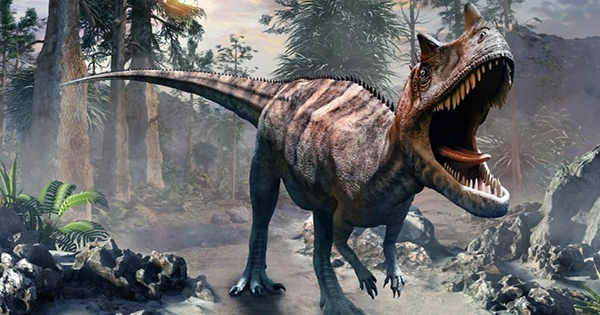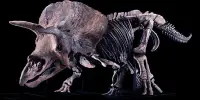These days, dinosaurs are in the headlines for more than simply ground-breaking discoveries.
Paleontologists are becoming more and more concerned about high-profile auctions where dinosaur specimens fetch exorbitant prices. The most recent instance is a 77 million-year-old Gorgosaurus skeleton that Sotheby’s sold in August 2022 for more than US$6 million.
However, that is far from the highest price ever paid for a dinosaur. A Deinonychus skeleton sold by Christie’s for $12.4 million in May 2022. The Department of Culture and Tourism in Abu Dhabi also spent an astounding $31.8 million for Stan, a remarkable T. rex from South Dakota’s Hell Creek Formation that will serve as the focal point of the city’s new natural history museum.
Some scientists are outspoken because they are so appalled. Paleontologist Steve Brusatte from the University of Edinburgh claimed in an interview with the Daily Mail that auction houses reduce priceless fossils to “nothing more than trinkets for the rich.” Even more bluntly, Thomas Carr from Carthage College in Wisconsin said, “Greed for money is what motivates these auctions.” He also criticized rich elites, such as actors Nicholas Cage and Leonardo DiCaprio, for engaging in a childish game of one-upmanship in which they compete to obtain the greatest specimens, calling them “thieves of time.”
The majority of reviewers attribute Sue, the largest and most complete T. rex yet discovered, for the burgeoning market for dinosaurs. The Field Museum of Natural History in Chicago purchased it for more than $8 million in 1997 after the FBI seized it from the same group of fossil hunters that discovered Stan. Disney and McDonald’s provided financial support for the purchase.
The commercial specimen trade, however, is as old as the field of paleontology itself, as I explain in my most recent book, “Assembling the Dinosaur.” And as its past demonstrates, the argument over whether or not dinosaurs should be traded and purchased raises much deeper issues regarding the long-standing but contentious connection between science and commerce.
The argument has two sides: Paleontologists have excellent reasons to object to the sale of priceless fossils for profit. Paleontologists have no means to determine whether new findings are accurate if specimens aren’t available for public inspection. Science is fundamentally a community endeavor. What if a particularly absurd idea is founded on a fake sample?
It occurs more frequently than you might imagine. A private collector bought what seemed to be a feathered dinosaur at the Tucson Gem and Mineral Show in the late 1990s. It was then widely publicized by National Geographic, which asserted that it represented the “missing link” between dinosaurs and contemporary birds.
Rich benefactors keep a distance from one another: Both arguments have strong points that are worth considering. But as the controversy surrounding “Archaeoraptor” demonstrates, it’s important to consider whether financial incentives damage confidence.
Geologists initially became aware of dinosaurs in the 19th century. In actuality, Richard Owen, a comparative anatomist, did not create the biological order “Dinosauria” until 1842, when these enormous lizards finally got their name.
Dinosaurs were treated by scientists at the time in the same manner as other riches that might be taken up from the ground, such as gold, silver, and coal. Many times utilizing money supplied by wealthy businessmen like Andrew Carnegie, who even had a dinosaur named after him, the Diplodocus carnegii, museums bought the majority of their fossils from commercial collectors.
When there was a determined push to decommodify dinosaur bones at the very end of the 19th century, things started to change, and museums started to remove themselves from the commercial specimen trade.
Rich donors to museums who wished to distinguish their humanitarian endeavors from the shady world of business provided one incentive. Philanthropists like Carnegie and J.P. Morgan donated money to cultural institutions not to conduct business but rather to demonstrate their affluence, love of knowledge, and republican values.
Additionally, the first Gilded Age paralleled the current era in that it too experienced a dramatic rise in economic disparity. This resulted in the widespread class struggle, which was often quite deadly and violent. Rich elites started utilizing public demonstrations of conspicuous generosity to show that American capitalism could produce public goods in addition to profits because they were afraid that fiery labor leaders would bring the industrial sector to its knees.
For all of these reasons, it was crucial for their charitable endeavors to be perceived as completely separate from the fierce struggle of the marketplace and as acts of unselfish real compassion.
Scientists assume command: Paleontologists adopted the language of “pure science” around the same time to assert that they developed information for its own purpose and not for financial benefit.
Scientists increased their credibility by claiming that the corrupting influence of money had no effect on their research.
Ironically, scientists discovered they could obtain more funding by professing to have zero interest in money, making them the ideal recipients of the charitable generosity of wealthy elites. But that also called for a distinct line to be drawn between the culture of capitalism and the conduct of science, which meant being reluctant to buy specimens.
As scientists started to reject the commercial specimen trade, museums started to arrange ever-more-ambitious trips that allowed scientists to gather fossils on their own. These expeditions were made possible by the kind donations of affluent patrons.
In the New Gilded Age, dinosaurs: However, they were not always able to maintain control over the black market for dinosaur bones. It has roared back with the United States in the midst of what some refer to as a New Gilded Age.
The most impressive dinosaur fossils found to date are frequently found in northeastern China’s Jehol deposit. Additionally, they are frequently bought from nearby farmers who supplement their wages by going fossil hunting on the side.
As a result, the debate over whether business incentives undermine trust has resurfaced. More than 80% of all marine reptiles are on display in Chinese museums, according to Li Chun, a professor at Beijing’s esteemed Institute for Vertebrate Paleontology and Paleoanthropology. This deceptive alteration is frequently done to boost the value of the exhibits.
The age-old concern about whether the business incentive actually poses a danger to science’s values is valid. But it is not really specific to paleontology.
A particularly well-known instance of commercial dishonesty combined with scientific malfeasance is the stunning collapse of Theranos, a tech business that received more than $700 million in venture money based on false promises of having invented a better way to do blood testing. Exxon’s decision to conceal its early climate change research and Moderna’s recent move to start enforcing its patent on the mRNA technology behind the most effective COVID-19 vaccines are just two examples of how much scientific research is now funded by those who have a commercial stake in the knowledge produced.














